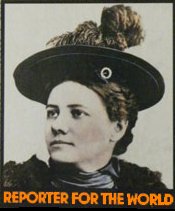Nellie Bly(1864 - 1922) |
|
The woman who would become famous as Nellie Bly was born Elizabeth Jane Cochran on May 5, 1864. She was the child of a prominent judge and a loving mother in Cochran's Mills, PA, just forty miles northeast of Pittsburgh. Before becoming known as Nellie, Jane acquired the nickname of "Pink" when her mother christened her in a bright pink gown. Perhaps it was an omen of things to come and of the many molds Jane (Pink) would break in her lifetime. Pink's father died at an early age, leaving her mother, Pink, and fourteen siblings hopelessly behind. With no legal will, Pink's mother had no claim to his estate. Mrs. Cochran and the children were suddenly reduced to modest means. When Mrs. Cochran remarried to an abusive man, Pink fled, searching for both escape and an income. At sixteen Pink found herself in Pittsburgh. She pursued work only to find employment available for women was extremely low paying. In 1885 Pink read a newspaper column in the Pittsburgh Dispatch entitled "What Girls Are Good For." The article implied women were only adept at raising children and performing housework. This prompted Pink's passionate response. Her letter to the newspaper was signed anonymously as the Lonely Orphan Girl. It caught the attention of the editor, who later found her through an ad in his own paper and offered her a job. It was an era when women writers used pen names. The Pittsburgh Dispatch offered Pink the pen name Nellie Bly, after the character in a song written 35 years earlier by another famous Pittsburgher, Stephen Foster. She gladly accepted. The newly anointed Nellie began writing about ordinary life and eventually turned her attention to working women. She became interested in the rights of women in a newly industrialized society. Far from merely advocating a more significant role for women, Nellie became one of the pioneers of investigative and undercover reporting, often placing herself in harm's way. Of course being outspoken had its price. When one of the Dispatch's advertisers threatened to withdraw their advertising from the Pittsburgh paper because of her stories, Nellie was reassigned to the social and fashion beat. Not one to settle down and do what she was told, Nellie left for Mexico and started writing for the Dispatch about corruption and poverty under the rule of Dictator Porfirio Diaz. She again found trouble, this time with the Mexican government, and was forced to leave the country or face being arrested. When Nellie returned to the United States she headed directly for New York, soon landing a job at the New York World working for Joseph Pulitzer in 1887. One of her most famous assignments was going undercover at an insane asylum for ten days to report on the neglect and brutal abuse of the patients at the Women's Lunatic Asylum on Blackwell's Island in New York. Nellie's work brought about much-needed reforms in patient treatment. She found some patients were suffering from physical, not mental, illnesses, while others had been locked away by family members for selfish reasons. She published her experience in book form entitled Ten Days in a Mad-House, published in 1887. A year later, Nellie determined to take a trip around the world like the adventurer in Jules Verne's book Around the World in Eighty Days. Nellie started her 24,899 mile, world-wide adventure on November 14, 1889, at 9:40:30 a.m. Her articles were published daily in the New York World. The newspaper held a contest entered by over 1 million people who guessed how long it would take Nellie to complete her journey. Nellie Bly broke the record of 80 days with a completion time of 72 days, 6 hours, 11 minutes and 14 seconds. Her return to New York was greeted by massive and adoring crowds, brass bands, parades, and fireworks. This record-breaking adventure brought Nellie world acclaim and the newspaper many more subscribers. In addition to writing about her journey for the paper Nellie also covered her adventures in a book entitled Around the World in Seventy-Two Days. Nellie retired from journalism (or so she thought) when she married a millionaire forty-two years her senior, Robert Livingston Seaman. Robert was 72 and they remained married until his death ten years later. After Seaman's death Nellie focused on running her late husband's company, The Iron Clad Manufacturing Company. Nellie forced many changes for the employees' benefit, including the construction of a recreation center and libraries. She also established employee clubs and gymnasiums, all on site. Despite these good intentions, Nellie led the company into bankruptcy due to financial mismanagement. Seeking an escape from her financial problems, Nellie Bly sailed to England in 1914 for a holiday. She happened to be on the Continent when World War I broke out and started reporting again as a war correspondent from the Eastern Front for the New York Evening Journal. She remained in Europe until 1919, returning home to be with her mother whose health was failing. Nellie was unaware that her own health had also been compromised. Nellie Bly died of pneumonia in New York City at St. Mark's Hospital on January 27, 1922 at the age of 57. Her passing was noted with much fanfare throughout the world. There were extensive and flattering obituaries, but Nellie Bly was buried in a modest grave in Woodlawn Cemetery in the Bronx, NY. |
|
Previous Page |
Return Home |